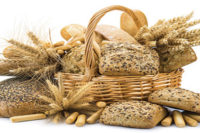Prior to joining the Grain Foods Foundation (GFF), I knew a few basic things about grains: They provide fiber. They are an essential part of a healthy, balanced diet. They often bring families and friends together to break bread and share memories. But grains—particularly whole grains—offer much more than I realized: They provide tremendous health benefits, while serving as earthy, hearty components of any meal plan. September marks National Whole Grains Month and thus is the perfect time to celebrate this nutritious and delicious food group.
Most Americans are aware that whole grains are necessary for a balanced diet. The USDA’s MyPlate recommendation emphasizes this fact, encouraging individuals to make half of their daily servings of grain whole grains. When incorporated regularly into the diet, whole grains offer a range of vital health benefits, including reducing the risk for chronic diseases and increasing nutrient intake. They are also an important source of nutrients, specifically dietary fiber, B vitamins and iron, that help lower the risk of heart disease and type 2 diabetes (“Why It Is Important to Eat Grains, Especially Whole Grains,” USDA, www.choosemyplate.com). And a recent study commissioned by GFF found that grains contribute nearly a quarter of a person’s daily fiber intake, helping lower blood cholesterol levels, regulate bowel movements and limit overeating by creating a feeling of fullness (“Dietary Fiber: Essential for a Healthy Diet,” Mayo Clinic, www.mayoclinic.org).
But while the dietary fiber in whole grains is part of what helps reduce these health concerns, 95 percent of Americans are not meeting the recommended daily fiber intake (“U.S. Dietary Guidelines Scientific Report 2015,” Office of Disease Prevention and Health Promotion, www.health.gov). A survey released in 2014 found that only 42 percent of American adults and 39 percent of children consume any whole grains in their diet, and only 8 percent of adults and 3 percent of children consume the recommended amount (“Total dietary fiber intakes in the U.S. population are related to whole grain consumption: results from the National Health and Nutrition Examination Survey 2009 to 2010,” Nutrition Research, March 2014). Despite the increasing popularity of diets such as the Mediterranean diet and Dietary Approaches to Stop Hypertension (DASH) eating patterns, whole grains are still not on enough dining room tables for a variety of reasons.
To help consumers quickly and easily spot whole-grain products, the Oldways Whole Grains Council created a packaging stamp in 2005 to label products that are 100 percent whole grain and that provide one full serving or more of whole grain (“Identifying Whole Grain Products,” Whole Grains Council, wholegraincouncil.org). Since its introduction, the stamp has helped consumers incorporate more whole grains into their diet by simply choosing pastas, breads and other foods bearing the stamp when grocery shopping.
In addition to being able to more easily identify common groceries with whole grains, consumers are being exposed to more unique grain products more frequently. Grocery chains now regularly stock ancient grains, with whole grains such as quinoa, teff and farro making their way onto more store shelves. But while these whole grains may be more accessible, many consumers find it challenging to incorporate them into their regular menus.To encourage consumers to try these ancient grains and experiment with whole grains, GFF provides both recipes and weekly meal plans on its website, www.grainfoodsfoundation.org. Additionally, the USDA’s MyPlate campaign includes fun, informational videos on how consumers can incorporate grains into the diets of picky eaters while on a budget.






